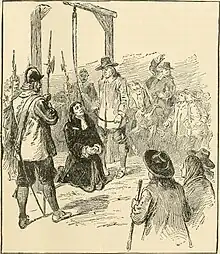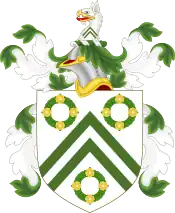George Burroughs
George Burroughs (c. 1650 – August 19, 1692) was a non-ordained Puritan preacher who was the only minister executed for witchcraft during the course of the Salem witch trials. He is remembered especially for reciting the Lord's Prayer during his execution, something it was believed a witch could never do.
George Burroughs | |
|---|---|
 Execution of Reverend George Burroughs, 1901 drawing | |
| Born | c. 1650 |
| Died | August 19, 1692 (aged 41–42) |
| Nationality | American |
| Alma mater | Harvard College |
| Occupation | Minister |
| Criminal charge(s) | Witchcraft (rehabilitated), Conspiracy with the Devil (rehabilitated) |
| Criminal penalty | Execution by hanging |
| Criminal status | Vacated |
Early life

George Burroughs may have been born in Suffolk, England, although some sources claim he was born in Scituate sometime in 1650.[1] Another source gives his birth date and place as Virginia, 1652.[2] He was raised by his mother in the town of Roxbury, Massachusetts.[3] As an American Congregational pastor, he graduated from Harvard College in 1670 with distinguished honors, where he was also considered an outstanding athlete.[4] He became the minister of Salem Village (now Danvers) in 1680 (where he would eventually be convicted of witchcraft and hanged). Burroughs became disillusioned with the community when they failed to pay his wages, and when his wife died suddenly in 1681, he resorted to borrowing money from community member John Putnam to pay for her funeral. He was unable to repay the debt, and resigned from his post, leaving Salem in 1683.[5]
Burroughs moved to Falmouth (now Portland, Maine), in which he lived until it was destroyed by the Wabanaki Confederacy in 1690. He then moved to Wells, Maine, believing it would be safer from Indian attacks.
Burroughs was described in a reading by Frances Hill: "George Burroughs was confident, strong-willed, and decisive, a man of action as well as a preacher, unusually athletic and clever enough to do well in Harvard. Short of stature, muscular, dark-complexioned, he was highly attractive to women, as is shown by his winning the hand of a rich widow as his second wife when he was a mere village minister."
Accusation and trial for witchcraft
Letters dated to 1691 from the Littlefields, founder of Wells, Maine, and in-laws to Peter Cloyce, and Rev. George Burroughs, signed by Peter's brothers John and Nathaniel, were sent to the Governor and Council to improve the conditions of Wells, Maine. Peter's second wife, Sarah Cloyce, sister of Rebecca Nurse and Mary Easty (or Eastey), relocated to Salem End, now West Framingham.[6]
Burroughs was arrested on charges of witchcraft on May 4, 1692,[7] based on the accusation of some personal enemies from his former congregation who had sued him for debt. At his trial, which took place in May, he was found guilty based on evidence that included his extraordinary feats of strength, such as lifting a musket by inserting his finger into the barrel (such feats of strength being presumed impossible without diabolical assistance[8]). His failure to baptise his children or to attend communion was also used as evidence of his guilt.[9] He was also suspected of killing his wives by witchcraft, and although clearly witchcraft was not involved, there is some historical evidence that he had treated them poorly.[10]
Suspicion of Being a Secret Baptist
Burroughs was suspected of being a crypto-Baptist for having failed to baptize his younger children, and this may be one of the roots of the hostility of Cotton Mather and others from the Congregational Church towards him.[11] During his cross-examination, he admitted that only his eldest child was baptized and on multiple occasions, had failed to take the sacrament at Sabbath services.[12] Baptists do not believe that one must take the sacrament (or "ordance") to be saved.[13]
Execution and aftermath
George Burroughs was hanged at Proctor's Ledge in present-day Salem on August 19, 1692. He was the only minister to have experienced this fate in American history. Although the jury had found no witches' marks on his body, he was nonetheless convicted of witchcraft and a conspiracy with the devil.
While standing on a ladder before the crowd, waiting to be hanged, he successfully recited the Lord's Prayer, something that was generally considered by the Court of Oyer and Terminer to be impossible for a witch to do. After he was killed, Cotton Mather, a minister from Boston, reminded the crowd from atop his horse that Burroughs had been convicted in a court of law, and spoke convincingly enough that four more were executed after Burroughs.
Below is the original account as first compiled and published in 1700 by Robert Calef in More Wonders of The Invisible World, and later reprinted or relied upon by others including Charles Wentworth Upham and George Lincoln Burr:
Mr. Burroughs was carried in a cart with others, through the streets of Salem, to execution. When he was upon the ladder, he made a speech for the clearing of his innocency, with such solemn and serious expressions as were to the admiration of all present; his prayer (which he concluded by repeating the Lord's Prayer) was so well worded, and uttered with such composedness as such fervency of spirit, as was very Affecting, and drew tears from many, so that it seemed to some that the spectators would hinder the execution. The accusers said the black man [Devil] stood and dictated to him. As soon as he was turned off [hanged], Mr. Cotton Mather, being mounted upon a horse, addressed himself to the people, partly to declare that he [Mr. Burroughs] was no ordained Minister, partly to possess the people of his guilt, saying that the devil often had been transformed into the Angel of Light. And this did somewhat appease the people, and the executions went on; when he [Mr. Burroughs] was cut down, he was dragged by a Halter to a hole, or grave, between the rocks, about two feet deep; his shirt and breeches being pulled off, and an old pair of trousers of one executed put on his lower parts: he was so put in, together with Willard and Carrier, that one of his hands, and his chin, and a foot of one of them, was left uncovered.
— Robert Calef
Later, the government of the Massachusetts colony recognized Burroughs' innocence and awarded 50 pounds damages to his widow and children, though this led to disputes over the division of the award among his heirs.[14] The gun said to have been used at his trial was for a time located at Fryeburg Academy in Fryeburg, Maine, having been taken there in 1808 for display in the Academy museum, but is believed to have since been destroyed in the Academy fire of 1850.[15]
See also
References
- Genealogy of the Burroughs Family, 1894. Compiled by L.A. Burroughs, p. 4
- Wilcox, Clifton (2012). Witch-hunt: The Assignment Of Blame. p. 27.
- "Reverend George Burroughs". Salem Witch Trials.
- Wilcox, Clifton. Witch-Hunt: The Assignment of Blame. p. 27.
- Wilcox, Clifton (2012). Witch-Hunt: The Assignment of Blame. pp. 28–29.
- The Baxter Manuscripts, Volume 5 ed by James Phinney Baxter. Letter from Fancis Littlefield and others to Governor and Councils. 1691 p. 274. Letter from Rev. Geo. Burrough to Governor and Council. Wells: Sept: 28th 1691 p 294.
- Hutchinson, Elisha (1692). "Warrant for apprehension of George Burroughs, and Officer's Return". Letter to.
- Godbeer, Richard (2018). The Salem Witch Hunt (2nd ed.). Boston, MA: Bedford/St. Martins. p. 140.
- Holmes, Clive (2016). "The Opinion of the Cambridge Association, 1 August 1692: A Neglected Text of the Salem Witch Trials". New England Quarterly: A Historical Review of New England Life and Letters. 89 (4): 652. doi:10.1162/TNEQ_a_00567. S2CID 57558631.
- Norton, Mary Beth (2003). In the devil's snare : the Salem witchcraft crisis of 1692. New York: Vintage eBooks. p. 125. ISBN 978-0-307-42636-9. OCLC 680524334.
- Baker, Emerson W. (August 19, 2014). "George Burroughs: Salem's perfect witch". oup.com. Oxford Universtiy Press. Retrieved July 31, 2023.
- "SWP No. 022: George Burroughs Executed, August 19, 1692". salem.lib.virginia.edu. University of Virginia Library. Retrieved July 31, 2023.
- "Baptists' Two Ordinances: Baptism and the Lord's Supper". baptistdistinctives.org. Baptist Distinctives. February 9, 2012. Retrieved July 31, 2023.
- "Reverend George Burroughs: Ringleader of the Salem Witches?". History of Massachusetts. April 9, 2017. Retrieved July 9, 2018.
- Souther, Samuel (1864). The Centennial Celebration of the Settlement of Fryeburg. Tyler & Seagrave. Retrieved February 5, 2019.
Sources
- Hill, Frances (1995). A Delusion of Satan. United States of America: Da Capo Press. pp. 55–59. ISBN 978-0-306-81159-3.
Further reading
- Upham, Charles (1980). Salem Witchcraft. New York: Frederick Ungar Publishing Co., 2 vv., v. 1 pp. 255, 278, 280, v. 2 pp. 140–63, 296–304, 319, 480, 482, 514.